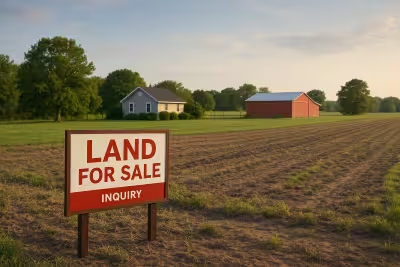When it comes to marketing undeveloped land — whether it's farmland, timberland, cropland, hunting land, or ranches — most real estate professionals focus their efforts on broad visibility through MLS, online platforms, social media, and land-specific listing sites. While these avenues are important, they overlook one of the most qualified, motivated, and often-overlooked buyer segments: adjoining property owners.
These neighbors aren't just casually interested in land. They often represent the most strategically positioned and financially qualified prospects. For listing brokers aiming to close deals faster and at better prices, targeted outreach to adjoining owners is not just a good idea—it's essential.
1. Higher Utilization Value
One of the primary reasons to market to adjoining property owners is that they are likely to derive greater value from the land than a random buyer. This concept, known in real estate circles as "plottage value," refers to the increased value that results from assembling adjacent parcels.
For example, a rancher who owns 300 acres adjacent to a 40-acre tract for sale could immediately integrate the additional land into their operations. This could mean more pasture, a new access point, or enhanced property control. Similarly, a timberland owner acquiring neighboring acreage benefits from operational efficiency, reduced per-acre management costs, and long-term investment potential.
Because the adjoining owner already understands the physical and economic context of the land, they can envision and execute on its potential much faster than an outsider, who might face a learning curve or a more limited use case.
2. Qualified and Capable Buyers
Adjoining landowners are not just good prospects—they are often the best. Why?
Because they already own land of a similar type and size, they are more likely to be financially qualified and familiar with the land buying process. They often have existing banking relationships, familiarity with land valuations, and in many cases, liquid assets or the ability to leverage existing equity.
From a broker's perspective, this reduces the friction of the sales process. These are not speculative buyers who are testing the waters. They know the land, the area, and the operational requirements. With fewer barriers to financing and due diligence, deals with adjoining owners tend to close faster and more smoothly.
3. Pre-Established Interest and Investment
An adjoining property owner has already demonstrated significant interest in the area—after all, they bought and maintain land there. That investment means they have emotional, logistical, and financial ties to the region. They are likely keeping an eye on the surrounding properties and may even have specific aspirations for expansion.
In rural land transactions, especially in close-knit agricultural or forestry communities, the value of local knowledge and commitment can't be overstated. A buyer who already understands the terrain, neighbors, access points, water rights, and other local nuances is far less risky than someone unfamiliar with the area.
4. They May Not Even Know It's For Sale
Here's the kicker: many adjoining landowners may never know the land next to them is on the market. Because they are not actively searching on Zillow, Lands of America, or Facebook groups, they miss the listing entirely.
This is why proactive outreach is critical. Sending a simple letter or postcard, especially one that visually shows the land for sale relative to their property, can be incredibly powerful. A well-timed, professional notification can turn a passive neighbor into a motivated buyer overnight.
5. Marketing to Neighbors is Simple and Affordable
Unlike broad marketing campaigns that require professional photography, drone footage, pay-per-click ads, and endless syndication, neighbor marketing is simple. Tools like AdjoiningOwner.com allow brokers to identify neighboring parcels, automatically generate personalized letters or postcards, and mail them in just a few clicks.
This hyper-targeted strategy doesn't replace traditional marketing—it complements it. But in many cases, it can outperform broader strategies by engaging those who have both the motive and the means to buy.
Final Thoughts
In the race to market and sell undeveloped land, brokers should never underestimate the power of proximity. Adjoining property owners are often:
- Highly qualified
- Deeply invested in the area
- Operationally motivated
- And completely unaware the parcel is for sale
That combination makes them one of the most valuable buyer segments for raw land. With the right tools and messaging, reaching them is easier than ever. For listing brokers focused on delivering results, targeting adjoining owners should be a standard part of every land marketing strategy.


